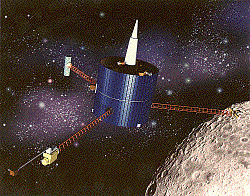www.moonlandings.co.uk
Moon Gravity | Far Side | Static Moon | Earth Facts | Top Ten Scientific Discoveries | Spinoffs | Landing Sites | The Future for the Moon | Water on the Moon? | Detailed Moon Statistics
Water on the Moon?
An abundant supply of water on the Moon would make establishment of a self-sustaining lunar colony much more feasible and less expensive than presently believed. Study of lunar samples revealed that the interior of the Moon is essentially devoid of water, so no underground supplies could be used by lunar inhabitants. However, the lunar surface is bombarded with water-rich objects such as comets, and scientists have suspected that some of the water in these objects could migrate to permanently dark areas at the lunar poles, perhaps accumulating to useable quantities. However, the controlled crash of NASA's Lunar Prospector spacecraft into a crater near the south pole of the Moon on 31 July 1999 produced no observable signature of water, according to scientists digging through data from Earth-based observatories and spacecraft such as the Hubble Space Telescope (NASA Release 99-119 13 October 1999)
the belief of water on the Moon started when the analysis of data returned from a radio-wave experiment performed in 1994 while the Clementine spacecraft was orbiting the Moon revealed that deposits of ice exist in permanently dark regions near the south pole of the Moon. Initial estimates suggested that the volume of a small lake exists: one billion cubic metres. For comparison, this amount of water would be equivalent to the fuel (hydrogen and oxygen) used for more than a million launches of the Space Shuttle from Cape Canaveral!
During the Apollo program, astronauts explored the surface of the Moon and brought back 382 kilograms of rock and dirt. These samples are completely devoid of water. In contrast to rocks on Earth, Moon rocks contain no water-bearing minerals, such as mica or clays. No surface features on the Moon were made by flowing water. Even the river-like sinuous rilles have been proven to be lava channels or collapsed lava tubes. These observations have given rise to the notion that the Moon is bone dry. But is it?
In the late 1970s, James Arnold of the University of California, San Diego, suggested that impacting comets and water-rich asteroids could add water to the lunar surface. Where would this water end up? Most of it would be split by sunlight into its constituent atoms of hydrogen and oxygen and lost into space, but some would migrate by literally hopping along to places where it is very cold. Arnold speculated that the polar regions might have areas that are permanently shadowed, hence permanently cold. The water might accumulate there (See 'Far Side')
Below: This Clementine topographic map of the Moon (red=high, purple=low -- each color equals 500 metres of elevation), shows the extent of the South Pole-Aitken basin. The basin is about 2500 km across and 13 km deep. Note that by chance, the south pole of the Moon falls inside the rim of the basin, leaving large areas in permanent darkness
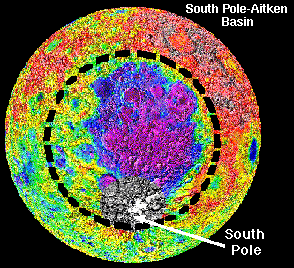
Because the south pole occurs just inside the rim of this deep hole, these regions are just below the "solar horizon" of the Moon and large areas of permanent darkness occur near the south pole. Permanently dark areas on the Moon have been hypothesized for many years, but their existence had not been confirmed before Clementine.
Two composite images of the lunar poles are shown below. These composite images (made up of many different orbits) show the lighting conditions at the north and south poles of the Moon throughout one lunar day. (One lunar day lasts 29 Earth days.) Note that for the north pole (left image), virtually every area gets some sunlight during some part of the lunar day. However, large areas of the south pole appear to be permanently dark (black on right polar image).
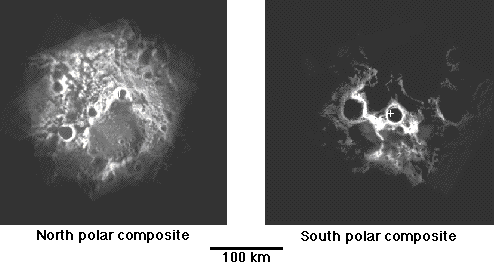
It has been calculated that temperatures in these permanently dark areas may be as cold as 40 to 50 Kelvin (-230o to -220o), only a few tens of degrees above absolute zero. Moreover, these 'cold traps' have existed on the Moon for at least the last 3-4 billion years - plenty of time to accumulate water from impacting comets.
Using Reflected Radio Waves
Although the Clementine spacecraft did not carry instruments designed to look for lunar ice, during the mission an experiment was improvised to allow scientists address this question. Radio waves are reflected from planetary surfaces differently depending on the compositional make up of those surfaces. Specifically, radio waves are scattered in all directions by reflection from surfaces made up of ground-up rock (as are the terrestrial planets, which include most of the Moon, Mercury, Venus, Mars and the asteroids), while radio waves are reflected more coherently from ice surfaces (the polar caps of Mercury and Mars and the icy surfaces of Jupiter's satellites Europa, Ganymede and Callisto). This happens because ice acts as a partly transparent medium for radio waves; think of ice as similar to a headlight reflector on a bicycle fender, which shines brightly when illuminated by light because of the many internal reflections produced by the translucent plastic of the reflector.
The Clementine team used the radio transmitter aboard the spacecraft to beam radio waves into the dark regions of the south pole of the Moon, into lighted regions of the south pole, and elsewhere on the Moon for comparison.
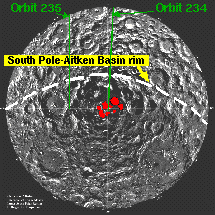
Echoes of these waves were obtained from the large dish antennas of the Deep Space Network on Earth. The image above, is a mosaic of the south polar region of the Moon. Permanently dark areas are shown in red. Two radar tracks (in green) are shown for orbits 235 (non-dark region) and orbit 234 (directly over the dark areas). The permanently dark regions around the south pole have the radar reflectance properties of ice, rather than the ground-up rock powder characteristic of the rest of the Moon's surface. Additional data taken on orbits where the reflected radio spots were not over these south polar regions and at the north pole do not show this ice signature.
This graph below shows the power of reflected radio energy for four orbits by the Clementine spacecraft plotted against the angle made by lines from the spacecraft to Earth and from the spacecraft to the target on the Moon. Orbits 301 and 302 were data taken over the north pole of the Moon (where very little permanently dark area is seen), while data from orbits 234 and 235 were taken in the vicinity of the south pole. If ice is present, the power should have a distinct 'peak' around beta = 0 (the 'bicycle reflector' effect), when spacecraft, target, and Earth all are aligned.
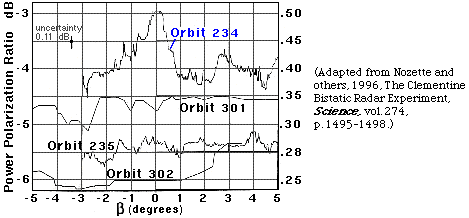
Note that a peak is seen only on orbit 234, which is the orbit directly over the dark areas near the south pole of the Moon. This graph is scientists' evidence for ice at the south pole of the Moon.
The lack of a peak is expected for all but the dark regions on the Moon because they are all illuminated by the Sun during the course of the lunar day. The total area of permanent darkness near the south pole exceeds 15,500 km2, about twice the areal extent of the island of Puerto Rico. The total amount of water is difficult to determine, but using the amount of permanently-shadowed area and the strength of the radar signal, we estimate that the total volume of ice is about cubic kilometre, an amount of water equivalent to that of a sizable lake.
The discovery of ice on the Moon would have enormous implications for a permanent human return to the Moon. Water ice is made up of hydrogen and oxygen, two elements vital to human life and space operations. Lunar ice could be mined and disassociated into hydrogen and oxygen by electric power provided by solar panels deployed in nearby illuminated areas or a nuclear generator. This hydrogen and oxygen is a prime rocket fuel, giving us the ability to refuel rockets at a lunar filling station and making transport to and from the Moon more economical by at least a factor of ten. Additionally, the water from lunar polar ice and oxygen generated from the ice could support a permanent facility or outpost on the Moon. The discovery of this material, rare on the Moon but so vital to human life and operations in space, would make our expansion into the Solar System easier and would reaffirm the immense value of our own Moon as the stepping stone into the universe.
When talking about the evtual colonisation of the Moon and the utilisation of its many mineral resources, an interesting question to ask would be who actually owns the Moon? The answer is that no one does. It is by international treaty understood to be free property (Source)
Since then, Prospector data have also been used to develop the first precise gravity map of the entire lunar surface. While the Moon's magnetic field is relatively weak, Prospector has confirmed the presence of local magnetic fields that create the two smallest magnetospheres in the Solar System. Another scientific landmark is the assembly of the first global maps of the Moon's elemental composition.
The $63 million Lunar Prospector mission was led by Dr. Alan Binder of the Lunar Research Institute, Tucson, AZ, and managed by NASA's Ames Research Center in Moffett Field, CA. It was built by Lockheed Martin Missiles & Space, Sunnyvale, CA. Other participating organisations included the Department of Energy's Los Alamos National Laboratory, NM, and NASA's Goddard Space Flight Center, Greenbelt, MD, and Jet Propulsion Laboratory, Pasadena, CA. (Further details: 1, 2, 3)
Lunar Prospector 